Performance Evaluation of Islamic Banking Services Industry: Evidence from GCC
Abstract
:1. Introduction
- First is the financial performance evaluation of the IBSI using conventional models (e.g., see Hanif et al. 2012; Siraj and Pillai 2012; Islam and Ashrafuzzaman 2015; Hazman et al. 2018).
- The second stream of literature develops the performance evaluation mechanism for the IBSI in light of specific objectives of the Islamic financial system (Mohammed et al. 2008, 2015; Mergaliyev et al. 2021).
- Third is the development of Shari’ah compliance ratings mechanism for the IBSI—with a focus on IFSI objectives (Ashraf and Lahsasna 2017; Hanif 2018).
- Whether the IBSI in the GCC region is stable and carries sufficient capital to remain solvent in the long run (capital adequacy);
- To what extent is the IBSI successful in handling the credit risk (non-performing loans);
- What is the performance of the IBSI’s management (cost to income);
- Whether the IBSI remained successful in generating sufficient regular earnings for investors (return on equity);
- Whether the IBSI carries sufficient liquid assets to ensure short-term solvency (liquidity management); and
- Finally, to identify the significant internal contributors to the performance of the IBSI in the GCC region.
2. Literature Review
3. Analytical Framework
- The primary level addresses the survival of Islamic banking by generating sufficient returns within Shari’ah constraints.
- The secondary level addresses broader economic objectives, including financial stability and equitable wealth distribution.
- Finally, the higher level contributes towards the social uplift of the marginal community groups by investing in social sectors.
- Capital—capital adequacy ratio (CAR), total regulatory capital/risk-weighted assets;
- Asset quality—non-performing finance (NPF), gross NPF/total financing;
- Management performance—cost-to-income ratio (CIR), operating costs/gross income;
- Earnings—return on equity (ROE), net income/equity; and
- Liquidity—liquid asset ratio (LAR), liquid assets/total assets.
4. Analysis and Findings
- The first milestone in IFSI history was the establishment of the Islamic Development Bank (IsDB) in Jeddah, KSA, in 1975. IsDB owners include 57 members of the Organisation of Islamic Cooperation (OIC); however, close to 45% of the shareholding is in the GCC region.
- The International Islamic Fiqh Academy (IIFA), established in 1981 in Jeddah, KSA, is a universal scholarly organization (a subsidiary organ of OIC) aimed at studying contemporary life issues and offering solutions through Ijtihad.
- The Accounting and Auditing Organisation for Islamic Financial Institutions (AAOIFI) was established in 1991 in Bahrain to develop and issue standards for the IFSI.
- The International Islamic Financial Market (IIFM) was established in 2002 in Bahrain, focusing on standardizing Shari’ah-compliant financial contracts and product confirmations.
- Dubai Islamic Bank is the oldest private-sector Islamic bank, established in 1975 in Dubai, UAE.
- JKAU: Islamic Economics (an international refereed journal), established in 1983 at King Abdulaziz University, KSA, is a pioneer outlet for disseminating IFSI-related academic literature.
- Dubai aims to be an Islamic finance hub (Kane 2014).
5. Concluding Remarks
Funding
Data Availability Statement
Conflicts of Interest
| 1 | Data for domestic branches not available for Bahrain. |
| 2 | Data for staff are not available for Kuwait and Bahrain. |
| 3 | Data for Qatar and Bahrain 2016Q4 and 2018Q1 onward, respectively. |
References
- Abdulrahman, Yahia. 2010. The Art of Islamic Banking and Finance: Tools and Techniques for Community-Based Banking, 1st ed. Hoboken: John Wiley & Sons. [Google Scholar]
- Abdulrehman, Asyraf H. J. 2000. The Concept Of Social Justice as Found in Sayyid Qutb’s Fi Ziljl Al-Qur’an. Ph.D. thesis, University of Edinburgh, Edinburgh, Scotland. [Google Scholar]
- AbuLoghod, Hadeel S. 2010. Do Islamic Banks Perform Better Than Conventional Banks? Evidence from Gulf Cooperation Council Countries. Working Paper. Available online: https://www.arab-api.org/APIPublicationDetailsEn.aspx?PublicationID=297 (accessed on 11 September 2022).
- Ahmad, Abu Umar Farooq, and Mohammad Kabir Hassan. 2007. Regulation and Performance of Islamic Banking in Bangladesh. Thunderbird International Business Review 49: 251–77. [Google Scholar] [CrossRef]
- Ali, Asif, Malik Faheem Bashir, and Muhammad Asim Afridi. 2021. Do Islamic Banks Perform Better than Conventional Banks? Turkish Journal of Islamic Economics 8: 1–17. [Google Scholar] [CrossRef]
- Ansari, Sanaullah, and Atiqa Rehman. 2011. Financial Performance of Islamic and Conventional Banks in Pakistan: A Comparative Study. Paper presented at 8th International Conference on Islamic Economics and Finance, Center for Islamic Economics and Finance, Qatar Faculty of Islamic Studies, Qatar Foundation, Doha, Qatar, March 15. [Google Scholar]
- Ashraf, Muhammad Adeel, and Ahcene Lahsasna. 2017. Proposal for a new Sharīʿah risk rating approach for Islamic banks. ISRA International Journal of Islamic Finance 9: 87–94. [Google Scholar] [CrossRef]
- Asutay, Mehmet. 2012. Conceptualising and Locating the Social Failure of Islamic Finance: Aspirations of Islamic Moral Economy vs the Realities of Islamic Finance. Asian and African Area Studies 11: 93–113. [Google Scholar]
- Ayub, Muhammad. 2018. Islamic finance crossing the 40-years milestone—The way forward. Intellectual Discourse 26: 463–84. [Google Scholar]
- Basel. 2019. Minimum Capital Requirements for Market Risk. Basel: Basel Committee on Banking Supervision, ISBN 978-92-9259-237-0 (online). [Google Scholar]
- BenSlimen, Rehab, Fethi Belhaj, Manel Hadriche, and Mohamed Ghroubi. 2022. Banking efficiency: A comparative study between islamic and conventional banks in gcc countries. Copernican Journal of Finance & Accounting 11: 89–106. [Google Scholar] [CrossRef]
- Chapra, M. Umar. 2008. Innovation and authenticity in Islamic finance. In Eighth Harvard University Forum on Islamic Finance on Innovation and Authenticity [April 19–20]. Cambridge: Harvard Law School. [Google Scholar]
- Fayed, Mona Esam. 2013. Comparative Performance Study of Conventional and Islamic Banking in Egypt. Journal of Applied Finance & Banking 3: 1–14. [Google Scholar]
- Hanif, Muhammad. 2018. Sharīʿah-compliance ratings of the Islamic financial services industry: A quantitative approach. ISRA International Journal of Islamic Finance 10: 162–84. [Google Scholar] [CrossRef]
- Hanif, Muhammad, and Kiran Zafar. 2020. Developments in Islamic Finance Literature: Evidence from Specialised Journals. Journal of King Abdulaziz University: Islamic Economics 33: 3–23. [Google Scholar]
- Hanif, Muhammad, and Muhammad Nauman Farooqi. 2023. Objective Performance Evaluation of the Islamic Banking Services Industry: Evidence from Pakistan. ISRA International Journal of Islamic Finance 15: 38–59. [Google Scholar] [CrossRef]
- Hanif, Muhammad, Mahvish Tahir, Arshia Tariq, and Wajeeh-ul-Momeneen. 2012. Comparative Performance Study of Conventional and Islamic Banking in Pakistan. International Research Journal of Finance and Economics 83: 62–72. [Google Scholar]
- Hazman, Samsudin, Nawawi Mod Nasir, Zairihan Abd Haleem, and Md Said Ahmad Syahmi. 2018. Financial Performance Evaluation of Islamic Banking System: A Comparative Study among Malaysia’s Banks. Jurnal Ekonomi Malaysia 52: 137–47. [Google Scholar]
- IFSB. 2022. Prudential and Structural Islamic Financial Indicators. Kuala Lumpur: Islamic Financial Services Board. Available online: https://www.ifsb.org/data-metadata/ (accessed on 4 April 2022).
- IFSBr. 2022. Islamic Financial Services Industry Stability Report. Kuala Lumpur: Islamic Financial Services Board. [Google Scholar]
- IFSBr. 2023. Islamic Financial Services Stability Report. Kuala Lumpur: Islamic Financial Services Board. [Google Scholar]
- Islam, Md Tanim ul, and Mohammad Ashrafuzzaman. 2015. A Comparative Study of Islamic and Conventional Banking in Bangladesh: Camel Analysis. Journal of Business and Technology (Dhaka) 10: 73–91. [Google Scholar] [CrossRef]
- Jaara, Bassam Omar Ali, Mohammad A. AL-Dahiyat, and Ismail AL-Takryty. 2021. The Determinants of Islamic and Conventional Banks Profitability in the GCC Region. International Journal of Financial Research 12: 78–91. [Google Scholar] [CrossRef]
- Kamaruddin, Badrul Hisham, Mohammad Samaun Safa, and Rohani Moh. 2008. Assessing Production Efficiency of Islamic Banks and Conventional Bank Islamic Windows in Malaysia. International Journal of Business and Management Research 1: 31–48. [Google Scholar]
- Kane, Frank. 2014. Business. The National News. December 30. Available online: https://www.thenationalnews.com/business/dubai-closer-to-becoming-islamic-finance-hub-1.637000 (accessed on 18 May 2024).
- Khokhar, Imran, Mahboob ul Hassan, Muhammad Nauman Khan, and Md Fouad BinAmin. 2020. Investigating the Efficiency of GCC Banking Sector: An Empirical Comparison of Islamic and Conventional Banks. International Journal of Financial Research 11: 220–35. [Google Scholar] [CrossRef]
- Latif, Youssef, Ali Abbas, Muhammad Nadeem Akram, Shahid Manzoor, and Saeed Ahmad. 2016. Study of performance comparison between Islamic and conventional banking in Pakistan. European Journal of Educational and Development Psychology 4: 17–33. [Google Scholar]
- Maudoodi, Syed Abul Aala. 1941. The Economic Problem of Man and its Islamic Solution [Speech at Muslim University Aligarh (20th October)], 3rd ed. Delhi: Markazi Maktaba Jamaat e Islami Hind. [Google Scholar]
- Mergaliyev, Arman, Mehmet Asutay, Alija Avdukic, and Yusuf Karbhari. 2021. Higher Ethical Objective (Maqasid al-Shari’ah) Augmented Framework for Islamic Banks: Assessing Ethical Performance and Exploring Its Determinants. Journal of Business Ethics 170: 797–834. [Google Scholar] [CrossRef]
- Mohammed, Mustafa Omar, Dzuljastri Abdul Razak, and Fauziah Md Taib. 2008. The Performance Measures of Islamic Banking Based on the Maqasid Framework. Paper presented at IIUM International Accounting Conference (INTAC IV), Putra Jaya Marroitt, Putrajaya, Malaysia, June 25; Available online: https://pdfs.semanticscholar.org/e636/a73ae59a7a2192c51994a3acfa636032b076.pdf?_ga=2.162074431.2085464327.1593956161-2068857030.1593956161 (accessed on 11 September 2022).
- Mohammed, Mustafa Omar, Kazi Md Tarique, and Rafikul Islam. 2015. Measuring the performance of Islamic banks using maqāṣid-based model. Special issue, Intellectual Discourse 23: 401–24. [Google Scholar]
- Obaidullah, Mohammed. 2005. Rating of Islamic Financial Institutions: Some Methodological Suggestions. Jeddah: Scientific Publishing Centre, King Abdulaziz University. [Google Scholar]
- Qureshi, Muhammad Hussain, and Kausar Abbas. 2019. Performance analysis of Islamic and traditional banks of Pakistan. International Journal of Economics, Management and Accounting 27: 83–104. [Google Scholar]
- Rasli, Salina, Nor Hazwani Binti Hassan, Salbiah Hanum Mohd Hajali, Jamilah Kamis, and Norhasbi Abdul Samad. 2020. CAMEL Characteristics, Financial Performance and Stability of Selected Islamic Banking in Malaysia. Special issue, Selangor Science &Technology Revie 4: 1–15. [Google Scholar]
- Rosly, Saiful Azhar, and Mohd Afandi Abu Bakar. 2003. Performance of Islamic and mainstream banks in Malaysia. International Journal of Social Economics 30: 1249–65. [Google Scholar] [CrossRef]
- Rozzani, Nabilah, and Rashidah Abdul Rahman. 2013. Camels and Performance Evaluation of Banks in Malaysia: Conventional Versus Islamic. Journal of Islamic Finance and Business Research 2: 36–45. [Google Scholar]
- Saged, Ali Ali Gobaili, Thabet Ahmad Abu Ahlaj, and Mohd Yakub Zulkifli Bi. 2017. The role of the Maqasid al-Sharīʿah in preserving the environment. Humanomics 33: 125–32. [Google Scholar] [CrossRef]
- Sairally, Salma. 2007. Evaluating the ‘Social Responsibility’ of Islamic Finance: Learning From the Experiences of Socially Responsible Investment Funds. In Advances in Islamic Economics and Finance. Edited by Iqbal Munawar. Jeddah: Islamic Research and Training Institute, Islamic Development Bank Group, vol. 1, pp. 279–320. [Google Scholar]
- Saleh, Ali Salman, and Rami Zeitun. 2007. Islamic Banks in Jordan: Performance and Efficiency Analysis. Review of Islamic Economics 11: 41–62. [Google Scholar]
- Samad, Abdus. 2004. Performance of Interest-free Islamic Banks vis-a-vis Interest-based Conventional Banks of Bahrain. IIUM Journal of Economics and Management 12: 1–15. [Google Scholar]
- Sillah, Bukhari M. S., and Nizar Harrathi. 2015. Bank Efficiency Analysis: Islamic Banks versus Conventional Banks in the Gulf Cooperation Council Countries 2006–2012. International Journal of Financial Research 6: 143–50. [Google Scholar] [CrossRef]
- Siraj, K. K., and P. Sudarsanan Pillai. 2012. Comparative Study on Performance of Islamic Banks and Conventional Banks in GCC region. Journal of Applied Finance & Banking 2: 123–61. [Google Scholar]
- Smolo, Edib, and Abbas Mirakhor. 2010. The global financial crisis and its implications for the Islamic financial industry. International Journal of Islamic and Middle Eastern Finance and Management 3: 372–85. [Google Scholar] [CrossRef]
- Usman, Abid, and Muhammad Kashif Khan. 2012. Evaluating the Financial Performance of Islamic and Conventional Banks of Pakistan: A Comparative Analysis. International Journal of Business and Social Science 3: 253–57. [Google Scholar]
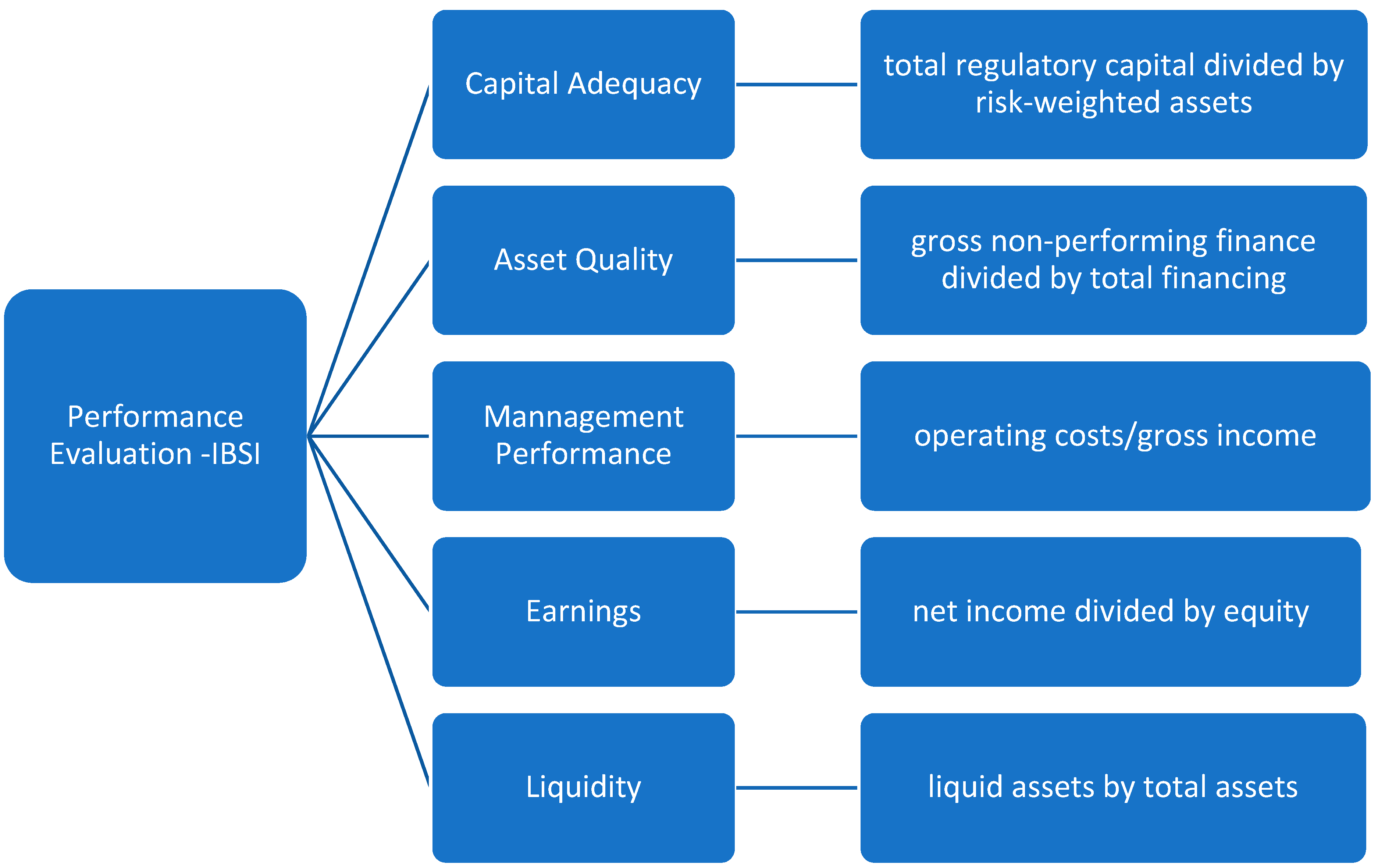
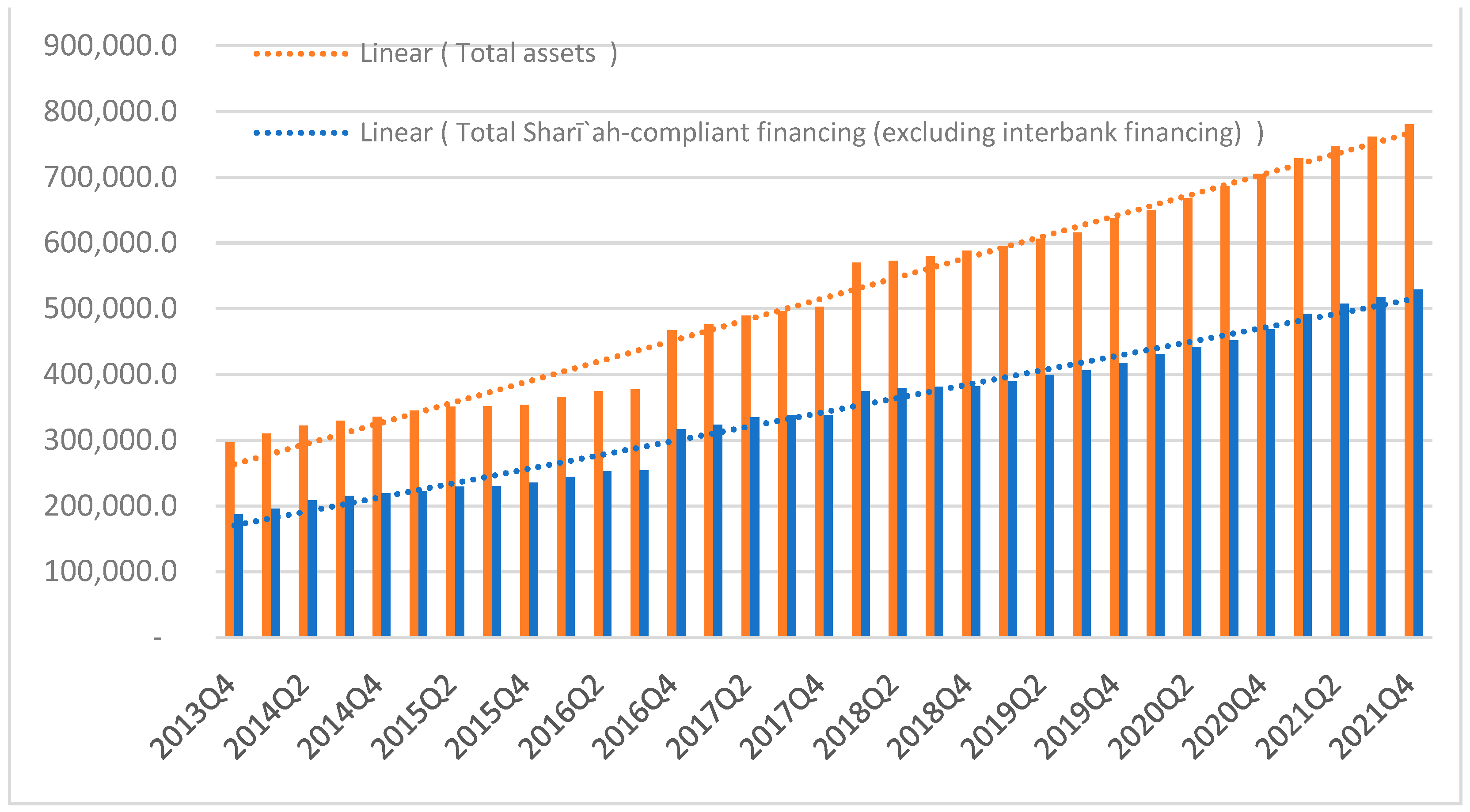
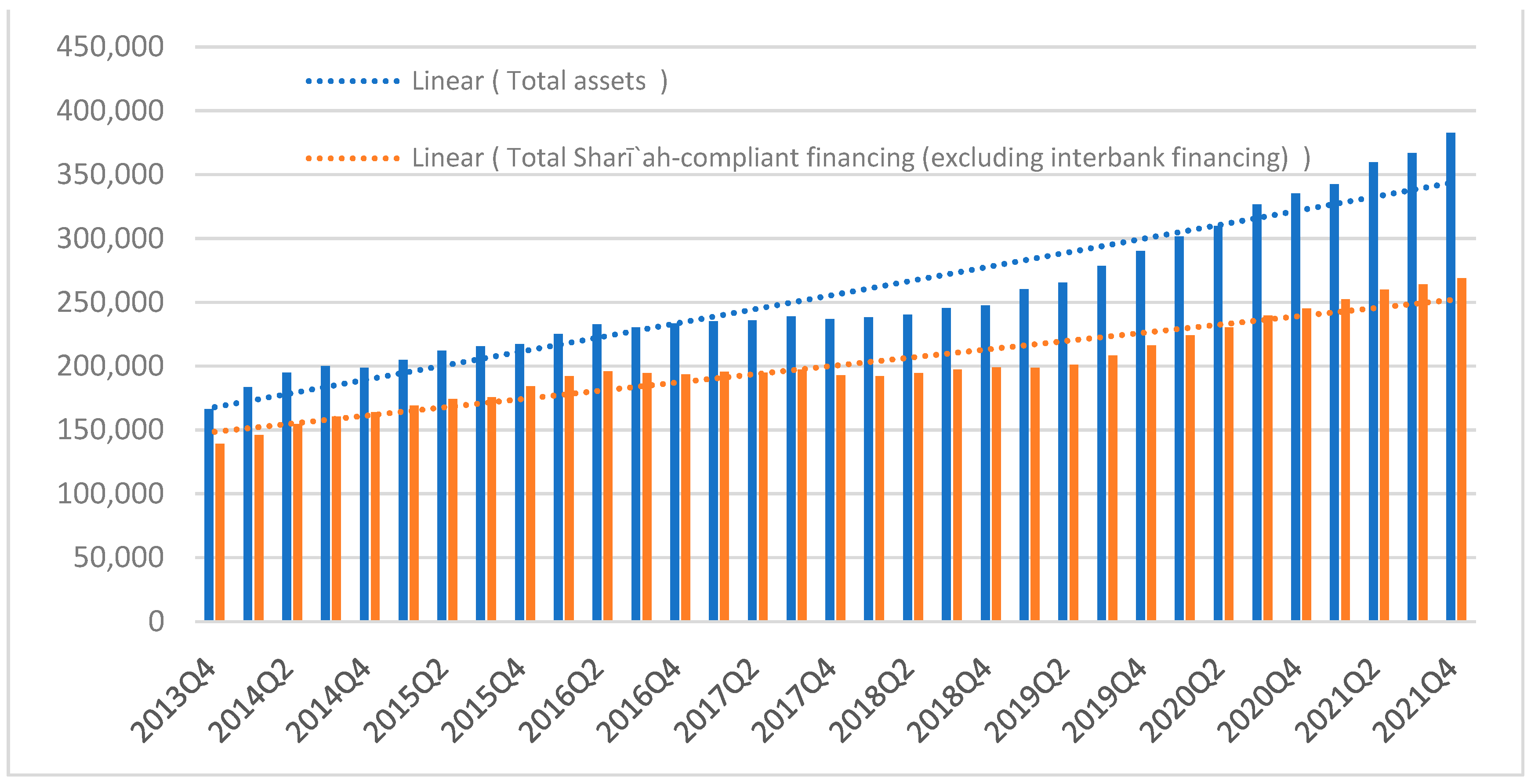

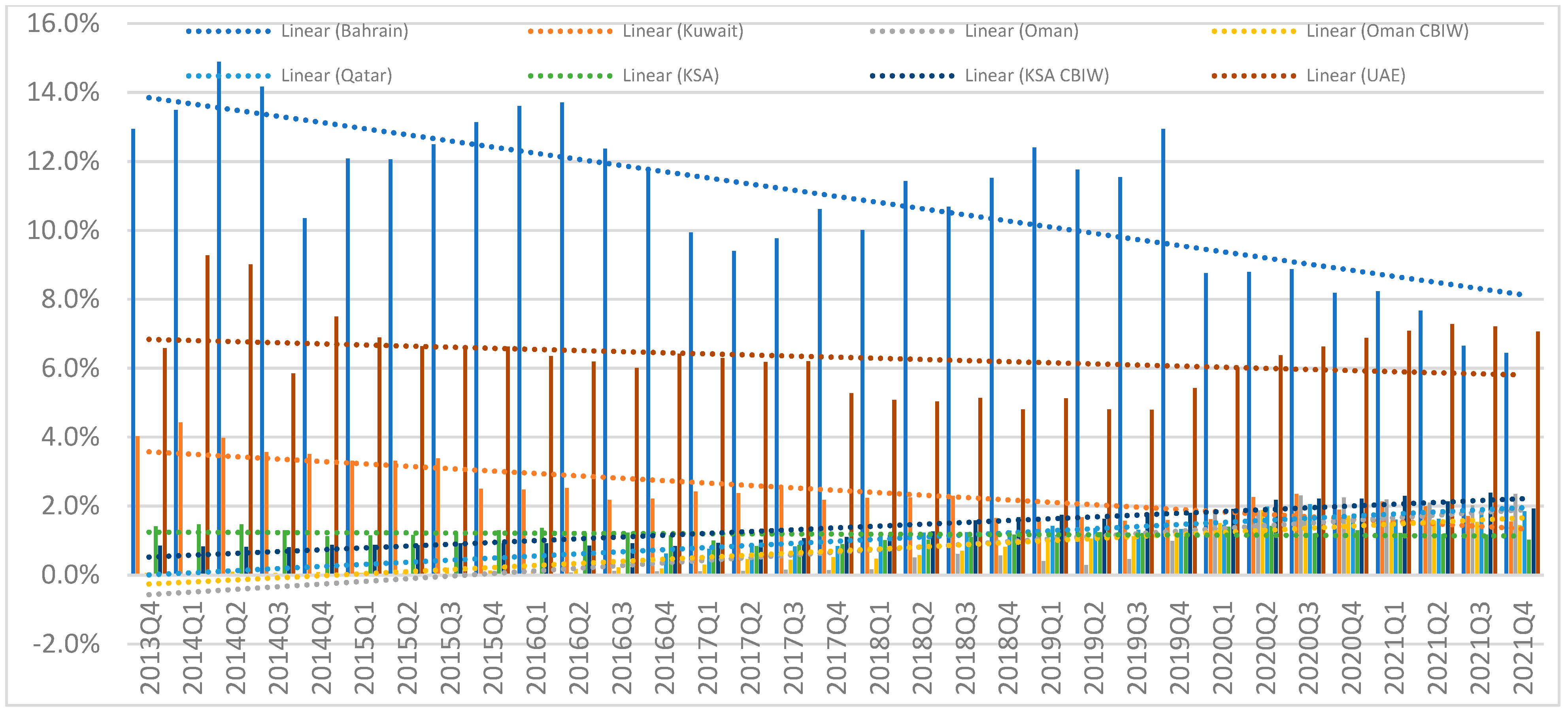
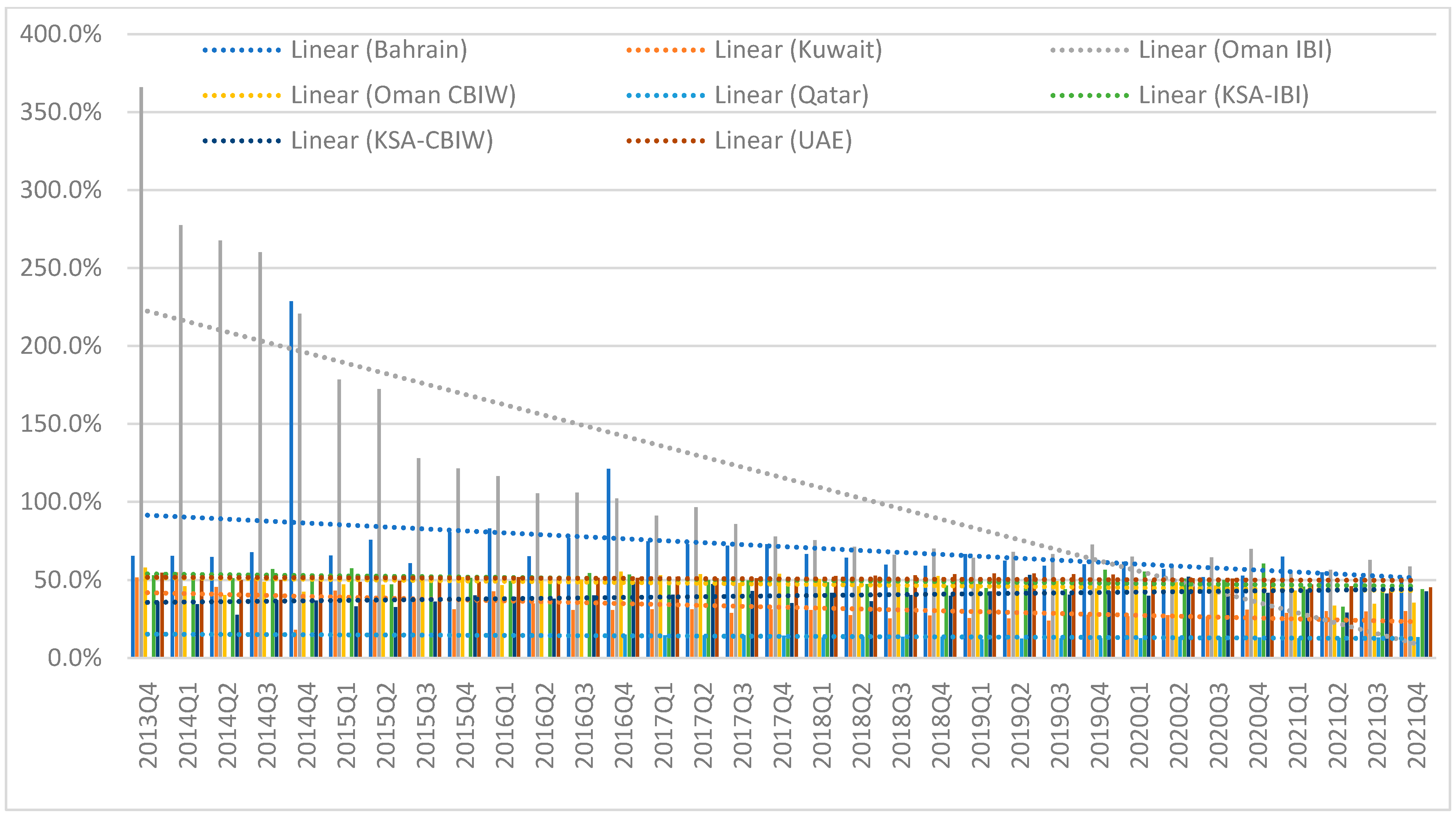

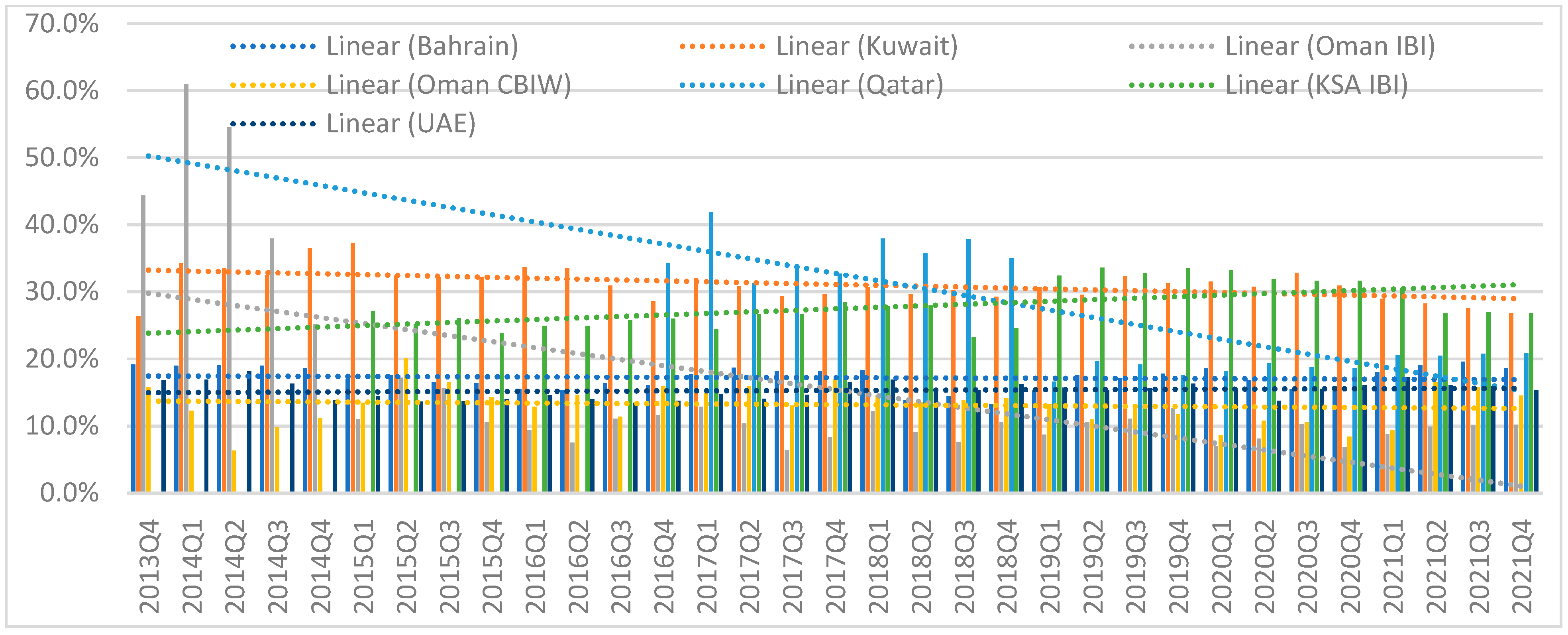
| Country | Market Share in Domestic Banking Assets | Share in Global Islamic Banking Assets | Volume of Assets USD B |
|---|---|---|---|
| Saudi Arabia | 77.2% | 30.6% | 643.9 |
| Kuwait | 51.9% | 6.3% | 132.6 |
| Qatar | 28.1% | 6.6% | 138.9 |
| UAE | 23.9% | 10.0% | 210.4 |
| Oman | 15.3% | 0.7% | 14.7 |
| Bahrain | 21.2% | 3.3% | 69.4 |
| 57.5% | 1209.9 | ||
| Total Global Islamic Banking Assets | 2104.1 | ||
| Ratios | Statistics | Bahrain | Kuwait | Oman IBI | Oman CBIW | Qatar | KSA IBI | KSA CBIW | UAE |
|---|---|---|---|---|---|---|---|---|---|
| CAR | Average | 18.7% | 17.8% | 28.8% | 16.2% | 18.0% | 20.1% | 17.1% | |
| St. Dev | 1.2% | 0.7% | 21.2% | 3.1% | 0.6% | 1.0% | 1.1% | ||
| Coef. Var | 6.6% | 4.2% | 73.6% | 19.1% | 3.3% | 5.1% | 6.2% | ||
| NPF | Average | 11.0% | 2.5% | 0.7% | 0.7% | 1.3% | 1.2% | 1.4% | 6.3% |
| St. Dev | 2.2% | 0.8% | 0.9% | 0.6% | 0.4% | 0.2% | 0.5% | 1.1% | |
| Coef. Var | 20.1% | 32.2% | 131.1% | 88.2% | 30.6% | 13.6% | 39.9% | 16.9% | |
| CIR | Average | 71.4% | 32.5% | 115.7% | 47.3% | 13.3% | 49.9% | 39.8% | 50.7% |
| St. Dev | 31.0% | 8.5% | 78.2% | 5.6% | 0.8% | 5.2% | 5.6% | 2.5% | |
| Coef. Var | 43.4% | 26.2% | 67.6% | 11.8% | 6.2% | 10.4% | 14.1% | 5.0% | |
| ROE | Average | 8.0% | 11.0% | −0.1% | 8.7% | 11.0% | 15.9% | 11.3% | |
| St. Dev | 6.5% | 2.9% | 5.4% | 2.2% | 5.1% | 2.6% | 2.5% | ||
| Coef. Var | 81.5% | 26.1% | −3934.5% | 25.5% | 46.4% | 16.3% | 21.8% | ||
| LAR | Average | 17.2% | 31.1% | 15.4% | 13.2% | 26.2% | 28.0% | 15.3% | |
| St. Dev | 1.7% | 2.5% | 13.7% | 2.9% | 8.6% | 3.3% | 1.2% | ||
| Coef. Var | 9.6% | 7.9% | 88.6% | 22.0% | 32.9% | 11.7% | 8.1% |
| CAR | NPF | CIR | LAR | ROE | |||||||||||
|---|---|---|---|---|---|---|---|---|---|---|---|---|---|---|---|
| Method | df | Value | Prob | df | Value | Prob | df | Value | Prob | df | Value | Prob | df | Value | Prob |
| ANOVA F-test | (6, 212) | 8.53 | 0.00 | (6, 212) | 412 | 0.00 | (6, 212) | 28.55 | 0.00 | (6, 212) | 42.64 | 0.00 | (6, 212) | 46.01 | 0.00 |
| Welch F-test * | (6, 92.6) | 30.12 | 0.00 | (6, 83.3) | 240 | 0.00 | (6, 90.2) | 1347 | 0.00 | (6, 86.8) | 249.4 | 0.00 | (6, 88.7) | 48.09 | 0.00 |
| Analysis of Var | |||||||||||||||
| Source of Var | df | Sum of Sq. | Mean Sq. | df | Sum of Sq. | Mean Sq. | df | Sum of Sq. | Mean Sq. | df | Sum of Sq. | Mean Sq. | df | Sum of Sq. | Mean Sq. |
| Between | 6 | 0.358 | 0.059 | 6 | 0.294 | 0.049 | 6 | 18.65 | 3.108 | 6 | 1.007 | 0.16 | 6 | 0.472 | 0.07 |
| Within | 212 | 1.486 | 0.007 | 212 | 0.025 | 0.000 | 212 | 23.08 | 0.108 | 212 | 0.834 | 0.00 | 212 | 0.363 | 0.00 |
| Total | 218 | 1.845 | 0.008 | 218 | 0.320 | 0.001 | 218 | 41.73 | 0.191 | 218 | 1.842 | 0.00 | 218 | 0.835 | 0.00 |
| CAR | CIR | DNPF | LAR | ROE | |
|---|---|---|---|---|---|
| CAR | 1.0000 | ||||
| CIR | 0.811 | 1.0000 | |||
| DNPF | −0.009 | −0.128 | 1.0000 | ||
| LAR | 0.370 | 0.0058 | −0.0462 | 1.0000 | |
| ROE | −0.431 | −0.569 | 0.0314 | 0.2569 | 1.0000 |
| Variables | ADF-Fisher Chi-Square | Probability * | PP-Fisher Chi-Square | Probability * | Result |
|---|---|---|---|---|---|
| CAR | 32.8906 | 0.0030 | 65.9934 | 0.0000 | I/Level |
| D-NPF | 93.6848 | 0.0000 | 136.706 | 0.0000 | I/1 |
| CIR | 40.7899 | 0.0002 | 80.8968 | 0.0000 | I/Level |
| ROE | 49.2176 | 0.0000 | 73.9904 | 0.0000 | I/Level |
| LAR | 48.2465 | 0.0000 | 34.4254 | 0.0018 | I/Level |
| Test Summary | Chi-Sq. Statistic | Chi-Sq. df | Prob. |
|---|---|---|---|
| Cross-section random with CAR | 3.216114 | 3 | 0.3595 |
| Cross-section random with CIR | 0.967422 | 3 | 0.8091 |
| Model-1 | Adj. R Square | F Stat | D.W Stat | Constant C | CAR | DNPF | LAR |
|---|---|---|---|---|---|---|---|
| Coefficients | 0.1391 | 12.36 | 1.217 | 0.120 | −0.265 | 0.471 | 0.122 |
| p Values | 0.0000 | 0.000 | 0.000 | 0.270 | 0.044 | ||
| T Stat | 7.08 | −5.46 | 1.10 | 2.02 | |||
| Model-2 | Adj. R Square | F Stat | D.W Stat | Constant C | CIR | DNPF | LAR |
| Coefficients | 0.1321 | 11.70 | 1.216 | 0.112 | −0.064 | 0.018 | 0.079 |
| p Values | 0.000 | 0.000 | 0.000 | 0.966 | 0.168 | ||
| T Stat | 6.047 | −5.210 | 0.042 | 1.381 |
| Period | S.E. | CAR | CIR | DNPF | LAR | ROE |
|---|---|---|---|---|---|---|
| 1 | 0.038 | 0.072 | 2.381 | 0.047 | 1.106 | 96.390 |
| (0.703) | (2.389) | (0.760) | (1.449) | (2.974) | ||
| 4 | 0.049 | 0.763 | 3.814 | 0.670 | 4.714 | 90.037 |
| (1.091) | (2.966) | (1.463) | (3.220) | (4.317) | ||
| 7 | 0.050 | 1.708 | 4.478 | 0.735 | 7.548 | 85.529 |
| (1.496) | (3.267) | (1.494) | (4.378) | (5.186) | ||
| 10 | 0.051 | 2.460 | 4.667 | 0.748 | 8.887 | 83.234 |
| (1.783) | (3.326) | (1.480) | (4.960) | (5.734) |
Disclaimer/Publisher’s Note: The statements, opinions and data contained in all publications are solely those of the individual author(s) and contributor(s) and not of MDPI and/or the editor(s). MDPI and/or the editor(s) disclaim responsibility for any injury to people or property resulting from any ideas, methods, instructions or products referred to in the content. |
© 2024 by the author. Licensee MDPI, Basel, Switzerland. This article is an open access article distributed under the terms and conditions of the Creative Commons Attribution (CC BY) license (https://creativecommons.org/licenses/by/4.0/).
Share and Cite
Hanif, M. Performance Evaluation of Islamic Banking Services Industry: Evidence from GCC. J. Risk Financial Manag. 2024, 17, 523. https://doi.org/10.3390/jrfm17110523
Hanif M. Performance Evaluation of Islamic Banking Services Industry: Evidence from GCC. Journal of Risk and Financial Management. 2024; 17(11):523. https://doi.org/10.3390/jrfm17110523
Chicago/Turabian StyleHanif, Muhammad. 2024. "Performance Evaluation of Islamic Banking Services Industry: Evidence from GCC" Journal of Risk and Financial Management 17, no. 11: 523. https://doi.org/10.3390/jrfm17110523
APA StyleHanif, M. (2024). Performance Evaluation of Islamic Banking Services Industry: Evidence from GCC. Journal of Risk and Financial Management, 17(11), 523. https://doi.org/10.3390/jrfm17110523







